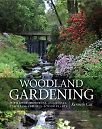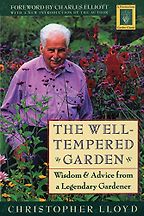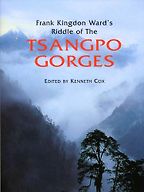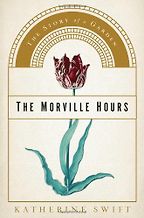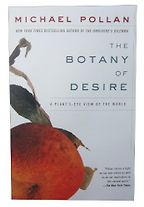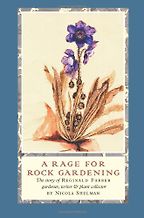There’s an awful lot of garden literature, full of fantastic factual and practical information, but most of it is rather dry and boring. Every generation essentially regurgitates the same information. As Alys Fowler, one of the new presenters on Gardeners’ World, recently commented, there’s little new to be said in gardening, it’s the same old information, just repackaged.
A bit like cookery literature – there’s nothing new under the sun?
A bit, although in cooking you have the potential to liven things up by doing fusion cooking between various continents. With plants, you can’t just take a bunch of tropical plants and shove them in the ground – it won’t work.
The books I’ve chosen are examples of great writing which happens to be about gardening. And all of them have original things to say.
So tell me about The Well-Tempered Garden, by Christopher Lloyd.
Christopher Lloyd was a life-long gentleman gardener, who wrote a column for The Observer. He was a flamboyant agent provocateur. Not only was he incredibly knowledgeable, he enjoyed winding people up and he knew exactly what he was doing. His garden at Great Dixter was a monument to his gardening skills and sometimes outrageous ideas. Any time someone said, ‘You should colour-coordinate,’ he would do the opposite: ‘I’m going to put orange with purple.’ The title of his book is slightly ironic, I think – The Well-Tempered Garden – because he was rather more interested in making bold and daring statements. He also had the courage to say, ‘This plant is a waste of space.’ I don’t always agree with him but I like the way he says it.
So what’s Great Dixter like?
It’s one of the great gardens of Britain. Lloyd’s style was gardening as theatre. For example, one day he decided to rip out the rose garden at Great Dixter which had been there for 60 years – ‘Roses are so last year, darling’ – which upset all the rose people. He could have done it quietly, but no, he loved the grand statement. He had a greenhouse full of plots of outrageous tropical plants, which he would put in his borders. But that was in later life. The Well-Tempered Garden, written in the 1970s, is a practical, very well-written book about his philosophy of gardening. It has remained in print ever since and is constantly being quoted. It’s a book any non-gardener could pick up and read and not be bored.
The next one is Riddle of the Tsangpo Gorges by Frank Kingdon Ward, edited by yourself.
This is one of a fairly tall pile of plant-hunting literature which came out from about 1850 to 1950. Frank Kingdon Ward wrote at least 20 books. The book covers his 1924-5 expedition to Southeast Tibet. It was probably his most daring and exciting trip and it contains the best descriptions of plants growing in the wild I can think of. It was out of print for about 60 years and if you were lucky enough to get your hands on a copy it was changing hands for £500. I and a couple of Americans spent 1995-1999 in this area retracing Kingdon Ward’s footsteps and going further. We republished this book illustrating everything that was in it in colour – the original only had a handful of black-and-white photos. Kingdon Ward died in the 1950s, but his second wife Jean Rasmussen is still alive and she attended the launch with his daughter and grandson.
When you went to Tibet, could you actually retrace his footsteps?
Yes, you could camp in the same campsites, take the same pictures, see the same trees – the book was that detailed and precise. We took some comparative photos and you could see the glaciers had retreated, but if you went to a particular spot in the campsite and Kingdon Ward said you’d find a particular plant there, you did find it. It’s probably the greatest plant-hunting book ever written. Most of the stuff he was finding was completely new. This is the book, for example, in which the blue poppy, Meconopsis betonicifolia, was discovered.
I have to say that the significance of that discovery had largely passed me by.
It’s a popular garden plant which has been written about copiously since then.
The third book is The Morville Hours, by Katherine Swift.
This is the most recent book of the list, it was published in 2008. It is quite the most ambitious book about gardening I’ve ever read. It’s in part a story of how Katherine Swift restored her National Trust property garden in Shropshire, which was the site of a medieval monastery. But it’s also a meditation about gardening and how the landscape of Shropshire became what it is over the last 2,000-3,000 years. And because she’s a medieval historian specialising in manuscripts it has the structure of the medieval services. It also runs through the seasons. It’s incredibly dense, full of the most treacly sentences and at times it feels a little bit like swimming in a vat of syrup. But it’s worth it. The book is quite melancholic – it’s the autobiography of a family running through three or four generations and she’s had quite a sad life, suffering from bouts of depression and estranged from her family. The book is clearly an act of catharsis and it pushes gardening literature in a direction I don’t remember it going before.
Which is?
A melange of history, meditation, self-exploration, philosophy, autobiography and geology. I can’t think of another gardening book so wide in its scope. And what’s also nice about it is that it has no photographs, only line drawings. It has an old world quality where you have to rely solely on her powers of description.
I imagine there’s a tendency in gardening writing, like cookery, to lapse into what you might call gardening pornography.
There’s certainly a tendency to be picture-led. None of the books on this list are picture-led, although we did add pictures to the new edition of the Frank Kingdon Ward book. These days the pictures tend to make up for rather dreary and unoriginal text.
What about the next one, The Botany of Desire,
by Michael Pollan?
Michael Pollan is an American journalist, a contributor to The New York Times Magazine, and a bestseller in the States. He was an amateur gardener who has turned into a food and plant writer, focusing in particular on where the American diet is going. This is a fairly simple book, a biography of four plants: the apple, the tulip, marijuana and the potato. The traditional view is that human beings have hybridised and selected plants for their own devices, and the human being is doing the manipulation. Pollan’s premise is essentially that of The Selfish Gene, although he doesn’t credit Richard Dawkins.
So this is the plants’ way of surviving?
He’s saying plants find ways of ingratiating themselves to humans to ensure their genetic material is perpetuated. With apples it’s sweetness, with potatoes their ability to stave off famine, with marijuana, getting high, with tulips their flamboyant colours. The plants may really be more in control of the process than we think.
I saw a television programme about dogs which put forward the same argument, that they are a parasitic species relying on the affection they trigger in humans to survive.
Yes, this is the same argument. I’m not sure Pollan’s theory is scientifically correct or more of a hunch, but it’s a tour de force. If he’d been an academic this would have been a rather tedious book, but he’s a journalist and because he comes to this as a professional writer, it’s a fun read. He delves out the most amazing information.
Your last one is A Rage for Rock Gardening: The Story of Reginald Farrer, Gardener, Writer and Plant Collector, by Nicola Shulman.
Shulman has written a very short biography of Reginald Farrer. He was the gardening writer of the Edwardian era, a closet gay and clearly a frustrated novelist. He more or less invented rock gardening. He was probably the first garden writer in the English language who decided that the writing was the important thing, the gardening secondary. His writing style is so affected and over-the-top, it’s ridiculous. He gilds every lily, it’s all spun sugar. During the First World War he went plant hunting and he was up against George Forrest, an Edinburgh plant hunter who wouldn’t let anyone stray on his patch, which as far as he was concerned was the whole of China. Farrer was terrified of Forrest and went off to various remote areas, mainly because he wasn’t allowed to go anywhere interesting.
Get the weekly Five Books newsletter
In 1918 he met my grandfather in London, took a fancy to him and said: ‘Would you like to go into Burma with me on a plant-hunting expedition?’ My grandfather was looking for an excuse not to go into the family business in Scotland, so off he went. Farrer then returned to Burma for another year and caught some tropical disease and died. My grandfather became his de facto executor and biographer.
It’s a wonderful read about a bygone era, with lots of quotes from Farrer’s writing. Shulman certainly gets under the skin of the situation. She laughs at Farrer’s fantastically over-rich writing style, while clearly loving it. One of the jokes was that since Farrer came across such insignificant plants on his expeditions – Forrest was nabbing all the good ones – he simply had to big them up.
And where do you situate your own writing? Are you too more interested in life, landscape, history, geology and philosophy than the plants themselves?
My last book, which was a guide to Scottish gardens, owed more to Christopher Lloyd in its writing style than anyone else. It’s slightly provocative. You owe it to your readers to not just give them information but to entertain. I fear that there aren’t going to be too many great gardening writers any more. We’re in an era where if you go on TV, you write loads of books. But being a great television presenter doesn’t mean you can write great books or have anything original to say. It’s a different skill.
Where’s the industry going?
At the moment gardening books aren’t selling well. Grow-your-own is very trendy, so everyone is writing veg books, even people who know nothing about veg, and they’re all the same. Everyone knows that Joy Larkin’s veg book, which came out about 20 years ago and has no pictures, was the best one and they all crib it. Some journalists are trying to muscle in on the gardening territory and often their books are inaccurate. They don’t know enough about the subject, they haven’t done their homework, and that’s just annoying. Gardening writing is in a bit of a crisis, and I don’t know where it’s heading. If you want to know, practically, how to do something, you just look it up on the internet, so I think the reference books will end up on the internet.
January 30, 2010. Updated: May 9, 2020
Five Books aims to keep its book recommendations and interviews up to date. If you are the interviewee and would like to update your choice of books (or even just what you say about them) please email us at [email protected]
Five Books interviews are expensive to produce. If you've enjoyed this interview, please support us by donating a small amount.

